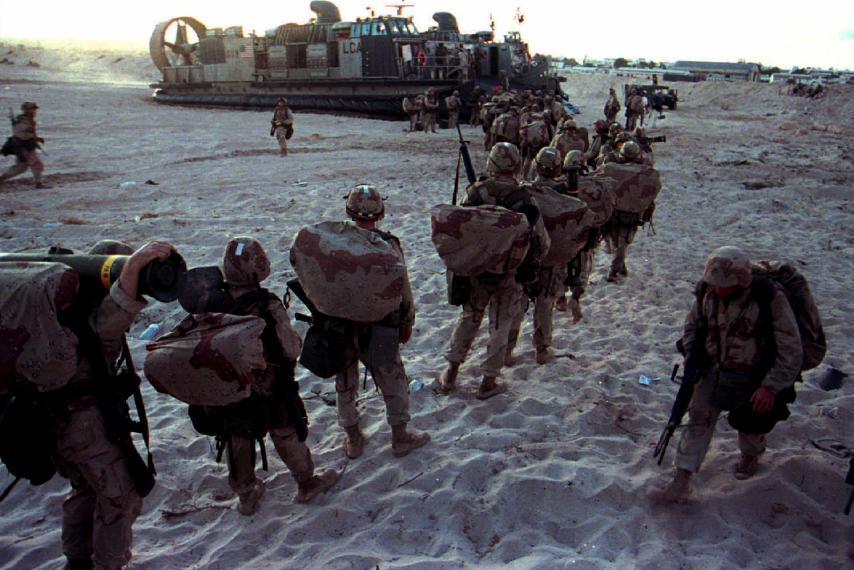Oct. 7, 1993: President Clinton orders extra troops to Somalia, charts exit plan

So now we face a choice. Do we leave when the job gets tough or when the job is well done?. Do we invite a return of mass suffering or do we leave in a way that gives the Somalis decent chance to survive?

By T. Roble
October 7, 1993: Four days after militias allied to then warlord Gen. Mohamed Farah Aidid brought down two US marines helicopters in what was to be immortalized as the Black Hawk Down and killing 14 soldiers, President Bill Clinton announced deployment additional 1,700 troops and outlined a withdrawal plan from Somalia.
“Today I have ordered 1,700 additional army troops and 104 additional armored vehicles to Somalia to protect our troops and to complete our mission. I’ve also ordered an aircraft carrier and two amphibious groups with 3600 combat Marines to be stationed offshore,” Clinton said in a televised national address.
The forces which would be under direct US command were tasked with protecting US bases, keep open and secure road transport and ‘to keep the pressure on those who cut off relief supplies and attacked our people.’
The downing of the two Black Hawks by Aidid’s militias had come barely four months after the US cut down its troop’s numbers from 28,000 to 4,700 in Somalia. The militias ramped up their onslaught against foreign troops starting with the killing of 12 Pakistani peace keepers.
EXIT PLAN
Even as Clinton warned against exit by other countries who had filled the gap left by US reduction, he was already laying out an exit plan as domestic pressure mounted back home. His announcement came briefly before he addressed the US Congress which had sought the President’s official position following the killing of American soldiers.
For Clinton, the mission had to be accomplished by the UN, Africans and importantly Somalis.
“It is not our job to rebuild Somalia society or even to create a political process that can allow Somalia’s clans to live and work in peace. The Somalis must do that for themselves,” Clinton said echoing what has becoming a more pronounced call a quarter century since then. “The United Nations and many African states are more than willing to help.”
Clinton also posed a forward looking question which would later confront future peace keeping missions in Somalia particularly Amisom. Leaders from troops contributing countries such as Kenya and Uganda have been under domestic pressure from their citizens following death of their troops serving under Amisom in Somalia.
“So now we face a choice. Do we leave when the job gets tough or when the job is well done? Do we invite a return of mass suffering or do we leave in a way that gives the Somalis decent chance to survive?”
In deploying additional soldiers, Clinton was categorical that he would be pulling out his troops in six months’ time which would be around March the following year.
“It is my judgment and out of my military advisors that we may need up to six months to complete the steps and to conduct an orderly withdrawal. We’ll do what we can to complete the mission before all American troops will be out of Somalia no later than March 31, said Clinton noting only a few hundred support personnel in non-combat roles would remain.
Indeed the last 1,100 marines left Somalia in March 24, 1994. The New York Times described it as a largely unsuccessful mission. “On that first day, Dec. 9, 1992, troops were greeted by cheering Somali crowds. Today there was none. Instead, there was scavenging and even looting at the American camps even as troops were packing.”
UNSUCCESFUL MISSION
Analysts accused the US of obsessing with the hunt of Gen. Aidid at the expense of the bigger picture which involved a political process.
“Ultimately, what might have become a blueprint for future missions evolved into an unsuccessful manhunt for a Somalia faction leader, Gen. Mohamed Farah Aidid, with heavy casualties for both sides,” the New York Times said. The newspaper however noted the reconciliation talks and signing of a truce between Gen. Aidid and his arch rival Mohamed Ali Mahdi in Nairobi in March 1994 calling for a ceasefire was a positive outcome for the US intervention. The ceasefire however did not hold.
A total of 1,800 US marines would return to Somalia in late February 1995 to evacuate the remaining 2,500 UN force as the battle between Gen. Aidid’s factions and the self-styled president Mohamed Ali Mahdi hit the crescendo.
Fast forward, 23 years since the abortive Operation Restore Hope, President Donald Trump announced last April the deployment of US troops to Somalia to bolster the war against the militant group Al-Shabaab.